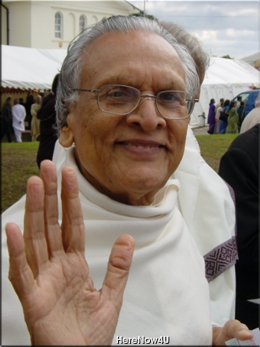
From a talk delivered by Gurudev Shree Chitrabhanu - April, 1978 - Fordham University
Jainism is a school of philosophy, a religion and a way of life, but its main emphasis is on living: the way of practice. The word used in the scriptures to describe the aim of Jainism is darshan. Darshan is to perceive, to see, and what is seen with the inner reality is called darshan. It is not only religion or philosophy, it is not only thinking, it is seeing. And when you see, you cannot help but practice, you live the principles.
| Philosophy means love for thinking. Herman Hesse was also not happy with this word, so he coined a new word, phiiosia, which means love of seeing. Love of thinking is not enough for darshan. Hence, Hesse has coined a new word Philosia that originates from darshan. |
The foundation of the teaching is practice-overcome your inner weaknesses and to do this we follow that person who has exemplified overcoming her/his inner weaknesses. Follow not the one who only talks, explains or promises but one who realizes and lives the teaching. You can feel from her/his life that she/he is living in a balanced state, in harmony with life. There are no conflicts, no fluctuations, no ups and downs. This Jain philosophy is very ancient. Many people think that it started with Mahavira, around 600 B.C., but that is not true. He was the last prophet of Jainism. Two hundred fifty years before Mahavira there was another Tirthankara named Parshvanath, who was born in Banaras. There is much more historical evidence about him. Also there were other Tirthankaras, some were prehistoric. Historians all agree that the oldest scriptures are the Vedas. According to Toynbee and other scholars, the Vedas are five to six thousand years old. And in the Vedas the names of the Jain Tirthankaras Rishabh (Adinath), Bharat, Arishtanemi are mentioned. This shows that even in the times of the Vedas,Jainismwas being practiced.
| The Sourcebook of Indian Philosophy, edited by Dr. Sarvepalli Radhakrishnan and Charles A. Moore, gives an excellent description of Jainism. (Princeton University Press) |
Jainism is realistic rather than idealistic. But its attitude of realism leads to idealism. It sees the world not as a dream, but as reality.
There is no school; which believes that the world is only maya, an illusion, a dream. That philosophy is idealistic. Jain's realism complements this school of idealism. Jainism says that this world is real and not a dream. It is tangible and expressible. In this sense, Jainism emphasizes the reality of things: of atoms, of matter. It sees that the world is a construction of atoms, a partnership between soul and matter. Gurudev Chitrabhanu
Gurudev Chitrabhanu
